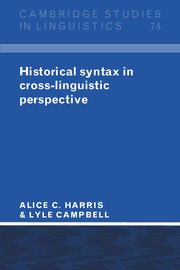Introduction
In Harris (2013), I showed how one kind of metathesis in Batsbi originates in derived transitive verbs. Metathesis is a phonological process by which two segments change order, for example XYZ becomes ZYX (where Y may be null). The goal of the present chapter is to show that in the speech of younger speakers the process I previously described has spread to intransitive verbs derived with the intransitivizing suffix -al.
In this chapter, I describe relevant aspects of the structure of verbs in Batsbi and briefly review the origins of metathesis in derived transitive verbs (Sections 2 and 3). I present in Section 4 a variety of morphological types of verbs, showing that metathesis does not occur in these. In Section 5, I present the facts of metathesis in derived intransitives, and in Section 6, I argue that metathesis spread from transitives to intransitives. Section 7 contains a brief conclusion.
Basic verb morphology in Batsbi
Batsbi is a native name for the language that the Georgians call Tsova Tush. It is spoken in a single village and is severely endangered, with the youngest speakers now around sixty, with a handful of exceptions.
For the purposes of this chapter we need morphological information primarily about the verb. Verbs may take a lexically governed gender–number prefix, illustrated in the left-hand column of (1). In the examples, d- is the default gender–number marker and stands in for the others. Not all verbs with gender–number prefixes occur in doublets of the kind in (1), but such examples are effective in showing that these prefixes are lexically governed. (In these examples, -ar forms the masdar, a declinable deverbal noun.)
(1) d–aħar “to take; bring; castrate” aħar “to steal; grind”
d–eblar “to place; lay; put down in” eblar “to thread; put”
d–ebc’ar “to tie” ebc’ar “to push; weigh; milk”
d–ot:ar “to pour into” ot:ar “to stand, stay”
d–ot’ar “to go; go over” ot’ar “to spread”
Gender–number affixes are glossed as “CM,” as they are traditionally known in the Caucasus as class markers. These markers indicate the gender and number of the subject of an intransitive (in the absolutive or ergative case, see below) or the direct object of a transitive.
